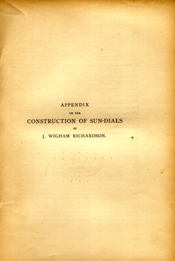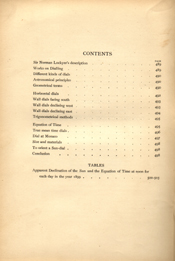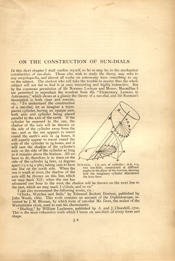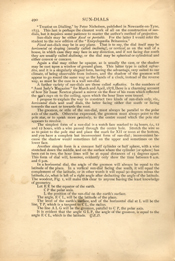APPENDIX
ON THE
CONSTRUCTION OF SUN-DIALS
BY
J. WIGHAM RICHARDSON.
CONTENTS
| PAGE | |
| Sir Norman Lockyer's description | 489 |
| Works on Dialling | 489 |
| Different kinds of dials | 490 |
| Astronomical principles | 490 |
| Geometrical terms | 490 |
| Horizontal dials | 492 |
| Wall dials facing south | 493 |
| Wall dials declining west | 493 |
| Wall dials declining east | 494 |
| Trigonometrical methods | 495 |
| Equation of Time | 495 |
| True mean time dials | 496 |
| Dial at Monaco | 497 |
| Size and materials | 498 |
| To orient a Sun-dial | 498 |
| Conclusion | 498 |
TABLES
| Apparent Declination of the Sun and the Equation of Time at noon for each day in the year 1899 | 500-503 |
SUN-DIAL. AB axis of cylinder; MN, PQ, two sun-dials, constructed at different angles to the plane of the horizon, showing how the imaginary cylinder determines the hour lines.
ON THE CONSTRUCTION OF SUN-DIALS
IN this short chapter I shall confine myself, as far as may be, to the mechanical construction of sun-dials. Those who wish to study the theory may refer to any encyclopædia, and almost all works on astronomy have something to say on the subject. The student who will take the trouble to master thus the whole subject will not fail to find it at once interesting and highly instructive. But by the courteous permission of Sir Norman Lockyer and Messrs. Macmillan I am permitted to reproduce the woodcut from the "Elementary Lessons in Astronomy," which shows at a glance the theory of a sun-dial, and Sir Norman's description is both clear and concise, viz.: "To understand the construction of a sun-dial, let us imagine a transparent cylinder, having an opaque axis, both axis and cylinder being placed parallel to the axis of the earth. If the cylinder be exposed to the sun, the shadow of the axis will be thrown on the side of the cylinder away form the sun; and as the sun appears to travel round the earth's axis in 24 hours, it will equally appear to travel round the axis of the cylinder in 24 hours, and it will cast the shadow of the cylinder's axis on the side of the cylinder as long as it remains above the horizon. All we have to do, therefore, is to trace on the side of the cylinder 24 lines, 15 degrees apart (15 × 24 = 360), taking care to have one line on the north side. When the sun is south at noon, the shadow of the axis will be thrown on this line, which we may mark XII; when the sun has advanced one hour to the west, the shadow will be thrown on the next line to the east, which we may mark I o'clock, and so on."
I can also recommend the following works, viz.:
"Clocks, Watches, and Bells," by Edmund Beckett Denison, published by John Weale, 1860. This work contains an account of the Dipleidoscope, invented by J. M. Bloxam, by which form of sun-dial Mr. Dent, the maker of the Westminster clock, used to rate his chronometer.
"Dialling," by William Leybourn, published by A. and J. Churchill, 1700. This is the most exhaustive work which I know on sun-dials of every form and shape.
"Treatise on Dialling," by Peter Nicholson, published in Newcastle-on-Tyne, 1833. This last is perhaps the clearest work of all on the construction of sun-dials, but it requires some patience to master the author's method of projection.
Sun-dials may be either fixed or portable. For the latter I would refer the student to the new edition of the "Encyclopædia Brittanica."
Fixed sun-dials may be in any plane. That is to say, the dial itself may be horizontal or sloping (usually called inclining), or vertical, as on the wall of a house, in which case they may face in any direction, and if not facing due south they are usually called declining, or the dial may be spherical or cylindrical and either convex or concave.
Again a dial may either be opaque, as is usually the case, or the shadow may be cast upon a window of ground glass. This latter type is called refractive, and it a singularly elegant form, having the advantage, very suited to our climate, of being observable from indoors, and the shadow of the gnomon will appear to go round the same way as the hands of a clock, instead of the reverse way, as must be the case in a wall sun-dial.
A further variety of sun-dials are those called reflective. In the numbers of "Aunt Judy's Magazine" for March and April, 1878, there is a charming account of how Sir Isaac Newton placed a mirror on the floor of his room which reflected the sun's rays on to the ceiling, upon which the hour lines were traced.
I propose to explain the way to construct two kinds of sun-dials only, viz., horizontal dials and wall dials, the latter facing either due south or facing towards the east or towards the west.
The gnomon, or stile of the sun-dial, must always be parallel to the polar axis of the earth. Otherwise expressed, the gnomon must always point to the pole star, or to speak more precisely, to the centre round which the pole star appears to revolve.
The simplest form of a sun-dial is a watch face marked to 24 hours, i.e., 12 and 12 hours, with a wire passed through the centre hole. Stretch the wire so as to point to the pole star and place the mark for XII or noon at the bottom, and you have a complete but inconvenient form of sun-dial; inconvenient because the shadow would sometimes fall on the upper and sometimes on the lower face.
Another simple form is a concave half cylinder or half sphere, with a wire stretched down the middle, and on the surface where the cylinder (or sphere) has been cut in two, the hour lines will be at equal distances of 15 degrees apart. This form of dial will, however, evidently only show the time between 6 a.m. and 6 p.m.
In a horizontal dial, the angle of the gnomon will always be equal to the latitude of the place. In a vertical sun-dial facing due south, it will equal the complement of the latitude, or in other words it will equal 90 degrees minus the latitude, i.e. what is left of a right angle after deducting the angle of the latitude. The woodcut, Fig. I, will make this clear to anyone having the least knowledge of geometry.
| Let | E E | be the equator of the earth. |
| C P | the polar axis. | |
| L | the position of the sun-dial on the earth's surface. |
The angle, E C L, will be the latitude of the place.
The level of the earth's surface, and of the horizontal dial at L will be the line, T P, which is a tangent to C L, the radius.
The line A L G will be the gnomon, parallel to C P, the polar axis.
It is evident that the angle G L P, the angle of the gnomon, is equal to the angle E C L, which is the latitude. Q.E.D.
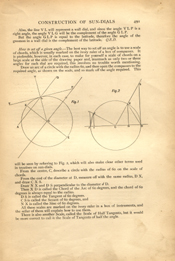
[Full Image]
Fig. 1. Fig. 2.
Also, the line V L will represent a wall dial, and since the angle V L P is a right angle, the angle V L G will be the complement of the angle G L P.
But the angle G L P is equal to the latitude, therefore the angle of the gnomon in a wall dial is the complement of the latitude. Q.E.D.
How to set off a given angle. — The best way to set off an angle is to use a scale of chords, which is usually marked on the ivory ruler of a box of compasses. It is preferable, however, in each case, to make for yourself a scale of chords on a large scale at the side of the drawing paper and, inasmuch as only two or three angles for each dial are required, this involves no trouble worth mentioning.
Draw an arc of a circle with the radius 60, and then open the compasses to the required angle, as shown on the scale, and so mark off the angle required. This will be seen by referring to Fig. 2, which will also make clear other terms used in treatises on sun-dials.
From the centre, C, describe a circle with the radius of 60 on the scale of chords.
From the end of the diameter at D, measure off with the same radius, D X, and draw C X S.
Draw N X and D S perpendicular to the diameter d D.
Then X D is called the Chord of the Arc of 60 degrees, and the chord of 60 degrees is always equal to the radius.
D S is called the Tangent of 60 degrees.
C S is called the Secant of 60 degrees, and
N X is called the Sine of 60 degrees.
All these scales are marked on the ivory ruler in a box of instruments, and the seller of them will explain how to use them.
There is also another Scale, called the Scale of Half Tangents, but it would be more correct to call it the Scale of Tangents of half the angle.
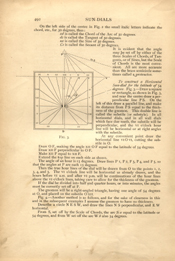
[Full Image]
FIG. 3.
On the left side of the centre in Fig. 2 the small italic letters indicate the chord, etc., for 30 degrees, thus:
xd is called the Chord of the Arc of 30 degrees.
ds is called the Tangent of 30 degrees.
nx is called the Sine of 30 degrees.
Cs is called the Secant of 30 degrees.
It is evident that the angle may be set off by either of the three Scales of Chords, of Tangents, or of Sines, but the Scale of Chords is the most convenient. All are more accurate than the brass semicircle sometimes called a protractor.
To construct a Horizontal Sun-dial for the latitude of 54 degrees. Fig. 3 — Draw a square or rectangle, as shown in Fig. 3, and near the centre draw a perpendicular line P S. On the left of this draw a parallel line, and make its distance from P S equal to the thickness of the gnomon. This double line is called the substile (or substyle). In all horizontal dials, and in all wall dials which face due south, the substile will be perpendicular, and the VI o'clock hour line will be horizontal or at right angles with the substile.
At any convenient point draw the horizontal line VI O VI, cutting the substile in O.
Draw O F, making the angle XII O F equal to the latitude of 54 degrees.
Draw XII F perpendicular to O F.
Make XII P equal to XII F.
Extend the top line on each side as shown.
The angle of an hour is 15 degrees. Draw lines P 1, P 2, P 3, P 4, and P 5, so that the angles at P are each 15 degrees.
Then the true hour lines of the dial will be drawn from O to the points 1, 2, 3, 4, and 5. The VI o'clock line will be horizontal as already drawn, and the hours before VI a.m. and after VI p.m. will be continuations of the hour lines above the VI o'clock lines, taking care to allow for the thickness of the gnomon.
If the dial be divided into half and quarter hours, or into minutes, the angles must be correctly set off at P.
The gnomon will be a right-angled triangle, having one angle of 54 degrees at O, and placed on the substile O XII.
Fig. 4 — Another method is as follows, and for the sake of clearness in this and in the subsequent examples I assume the gnomon to have no thickness.
Describe a circle N E S W, and draw the lines N S perpendicular, and E W horizontal.
From S, set off by the Scale of Chords, the arc S a equal to the latitude or 54 degrees, and from W set off the arc W b also 54 degrees.
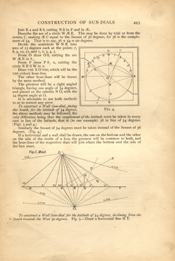
[Full Image]
FIG. 4.
Join E a and E b, cutting N S in P and in Æ.
Describe the arc of a circle W Æ E. This may be done by trial or from the centre, C, making Æ C equal to the Secant of 36 degrees, for 36 is the complement of 54. That is to say, 36 + 54 = 90 degrees.
Divide the semicircle W N E into arcs of 15 degrees each at the points 7, 8, 9, 10, 11 and 1, 2, 3, 4, 5.
From O draw O 8, cutting the arc W Æ E in 81.
From P draw P 81 x, cutting the circle N E S W in x.
Draw VIII X O VIII, which will be the VIII o'clock hour-line.
The other hour-lines will be drawn by the same method.
The gnomon will be a right-angled triangle, having one angle of 54 degrees, and placed on the substile N O, with the 54 degree angle at O.
It is advisable to use both methods so as to correct any error.
To construct a Wall Sun-dial, facing due South, for the latitude of 54 degrees, the above methods may be followed, the only difference being that the complement of the latitude must be taken in every case in lieu of the latitude, that is (in our example) 36 in lieu of 54 degrees. (Figs. 3 and 4.)
Similarly the Secant of 54 degrees must be taken instead of the Secant of 36 degrees. (Fig. 4.)
If a horizontal and a wall diall be drawn, the one on the bottom and the other on the side of the inside of a box, the gnomon will be common to both, and the hour-lines of the respective dials will join where the bottom and the side of the box meet.
To construct a Wall Sun-dial for the latitude of 54 degrees, declining from the South towards the West 30 degrees. Fig 5. — Draw a horizontal line H T.
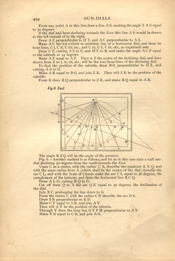
[Full Image]
Fig. 6. East
From any point A in this line draw a line A S, making the angle T A S equal to 30 degrees.
If the dial had been declining towards the East this line A S would be drawn to the left instead of to the right.
Draw A Z perpendicular to H T, and A C perpendicular to A S.
Make A C the XII o'clock or meridian line of a horizontal dial, and draw its hour-lines, C I, C II, C III, etc., and C XI, C X, C IX, etc., as explained ante.
Draw C P, cutting A S in P, and H T in B, and make the angle A C P equal to the latitude of 54 degrees.
Make A Z equal to A P. Then is Z the centre of the declining dial, and lines drawn from Z to I, II, III, etc., will be the true hour-lines of the declining dial.
To find the position of the substile, draw B G perpendicular to H T, and cutting A S in G.
Make A R equal to B G, and join Z R. Then will Z R be the position of the substile.
From R draw R Q perpendicular to Z R, and make R Q equal to A B.
The angle R Z Q will be the angle of the gnomon.
Fig. 6 — Another method is as follows, and let us in this case take a wall sun-dial declining 30 degrees from the south towards the East.
Upon C as a centre, with the radius C A, describe the quadrant A X Q, and with the same radius from A (which shall be the centre of the dial) describe the arc C L, and with the Scale of Chords make the arc C L equal to 36 degrees, the complement of the latitude, and draw the horizontal line R C Q.
Draw A L D, cutting R Q in D.
Cut off from Q to A the arc Q X equal to 30 degrees, the declination of the dial.
Join X C, prolonging the line down to S.
From the centre C with the radius C D describe the arc D S.
Draw S R perpendicular to R D.
Make C Y equal to S R, and join A Y.
Then will A Y be the position of the substile.
Through Y draw the long line G Y P M perpendicular to A Y.
Make Y G equal to C R, and join A G.
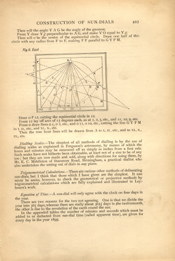
[Full Image]
Fig. 6. East
Then will the angle Y A G be the angle of the gnomon.
From Y draw Y g perpendicular to A G, and make Y O equal to Y g.
Then will O be the centre of the equinoctial circle. Draw one half of this circle with any radius from F to F, making F F parallel to G Y P M.
Draw O P 12, cutting the equinoctial circle in 12.
From 12 lay off arcs of 15 degrees each, as at 1, 2, 3, etc., and 11, 10, 9, etc.
From O draw lines O 1, O 2, etc., and O 11, O 10, etc., cutting the line G Y P M in I., II., etc. and XI., X., etc.
Then the true hour lines will be drawn from A to I., II., etc., and to XI., X., IX., etc.
Dialling Scales. — The simplest of all methods of dialling is by the use of dialling scales as explained in Ferguson's astronomy, by means of which the hours and minutes may be measured off as simply as inches from a foot rule. Such scales have not hitherto been obtainable, at least not of a size to be of any use; but they are now made and sold, along with directions for using them, by Mr. E. C. Middleton of Stanmore Road, Birmingham, a practical diallist who also undertakes the setting out of dials in any plane.
Trigonometrical Calculations. — There are various other methods of delineating sun-dials, but I think that those which I have given are the simplest. It can never be amiss, however, to check the geometrical or projective methods by trigonometrical calculations which are fully explained and illustrated in Leybourn's work.
Equation of Time. — A sun-dial will only agree with the clock on four days in the year.
There are two reasons for the two not agreeing. One is that we divide the year into 365 days, whereas there are really about 365 ¼ days in the twelvemonth, the other is due to the revolution of the earth round the sun.
In the appended tables the number of minutes and seconds which must be added to or deducted from the sun-dial time (called apparent time), are given for every day in the year 1899.
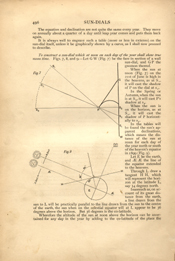
[Full Image]
Fig. 7.
Fig. 9.
The equation and declination are not quite the same every year. They move on annually about a quarter of a day until leap year comes and puts them back again.
It is always well to engrave such a table (more or less in extenso) on the sun-dial itself, unless it be graphically shown by a curve, as I shall now proceed to describe.
To construct a sun-dial which at noon on each day of the year shall show true mean time. Figs. 7, 8, and 9. — Let G W (Fig. 7) be the face in section of a wall sun-dial, and G P the gnomon thereof.
When the sun at noon (Fig. 7) on the 21st of June is high in the heavens, as at S1, it will cast the shadow of P on the dial at s1.
In the Spring or Autumn, when the sun is at S2, it will cast P's shadow at s2.
When the sun is on the horizon, as at S3, it will cast the shadow of P horizontally to s3.
In the tables will be found the sun's apparent declinations, which means the distance of the sun at noon for each day of the year north or south of the heaven's equator in 1899 (Fig. 9).
Let E be the earth, and Æ Æ the line of the equator extended to the heavens.
Through L draw a tangent H H, which will represent the horizon at the latitude L, say 54 degrees north.
Inasmuch as, on account of its great distance from the earth, a line drawn from the sun to L will be practically parallel to the line drawn from the sun to the centre of the earth, the sun when on the celestial equator will at L appear to be 36 degrees above the horizon. But 36 degrees is the co-latitude.
Wherefore the altitude of the sun at noon above the horizon can be ascertained for any day in the year by adding the co-latitude of the place the
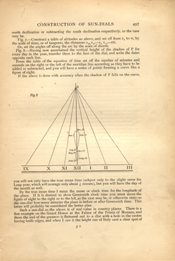
[Full Image]
Fig. 8.
north declination or subtracting the south declination respectively, as the case may be.
Fig. 7 — Construct a table of altitudes as above, and set off from s3 to w, by the scale of sines, or of tangents, the distances s1, s2, — s3, s1, — etc.
Or, set the angles off along the arc by the scale of chords.
Fig. 8. — Having now ascertained the vertical height of the shadow of P for every day of the year, transfer them to the face of the dial, and write the dates opposite each line.
From the table of the equation of time set off the number of minutes and seconds on the right or the left of the meridian according as they have to be added or subtracted, and you will have a series of points forming a curve like a figure of eight.
If the above is done with accuracy when the shadow of P falls on the curve, you will not only have the true mean time (subject only to the slight error for Leap year, which will average only about ¼ minute), but you will have the day of the month as well.
By the true mean time I mean the mean or clock time for the longitude of the place. If it is desired to show Greenwich clock time you must move the figure of eight to the right or to the left, as the case may be, or otherwise state on the sun-dial how many minutes the place is before or after Greenwich time. This latter will probably be considered the better plan.
Such a sun-dial as the above is of real value in country places. There is a fine example on the Guard House at the Palace of the Prince of Monaco, and there the end of the gnomon is flattened out to a disc with a hole in the centre having knife edges, and when I saw it the bright sun of Italy cast a clear spot of
light about the size of shilling on the lines of the curve, which, as well as the hour lines, were about ¾ inch broad. The sun-dial itself must have been 12 or 14 feet high.
On the size, the material, and the fabrication of sun-dials. — I sometimes think that when our architects are fain to put in a blank window to relieve part of the wall of a house, they might give us a sun-dial of large dimensions in place thereof. A sun-dial can hardly be too large, and it might very well cover the whole end of a barn, or even of a house.
If made of small size as is usual in England, the best material for horizontal dials is brass, and for wall dials slate, or marble, or granite.
In all cases the dial itself, or a full-size model, should be made first in the workshop.
To orient a sun-dial. — It will be useless to make a dial accurately, unless it be truly placed as regards the points of compass.
I recommend the following procedure in fixing a horizontal dial.
First consult a large Ordnance map (scale of an acre to a square inch), and place your dial approximately due north and south. Then level it by means of a spirit level.
Correct the line of the gnomon both by a compass and by the sun at noon, as rectified for the equation of time.
Then at the distance of some four or five yards north of the dial drive two long poles into the ground with a cross-piece at the top, like a tall Greek letter Π. The like, but not so tall, to the south of the dial.
Hang both north and south plummet lines, and during the day make the two lines and the gnomon in one line.
Ask any astronomical friend, or any ship's captain, at what hour the pole star crosses the meridian, at that hour get the two plummet lines in a line with the pole star 1. Be careful in doing this to move the one as much to the right as the other to the left, for otherwise the gnomon will not be in the same line.
Having got the plummet lines true to the pole star, it will not be difficult in the morning to adjust the gnomon.
For a wall declining dial the plan will be similar, but it will be necessary for one pair of the poles to project above the eaves.
I shall be much gratified if this appendix to the Book of Sun-dials adds to its value. If any youthful reader will take the trouble to construct a sun-dial he will find that it will teach him more astronomy than a course of popular lectures could afford him, and he will almost surely be led to study further the mysteries of the great firmament on high, and in so doing he will every year of his life more and more marvel at the extent of the Divine power and wisdom, and be prepared hereafter, when we shall no longer see only as through a glass darkly, to truly enjoy that fuller knowledge which will be one of the joys which an infinite Love destines for us above.
On a tomb in Westminster Abbey you may read:
"Man's life is measured by the workes, not dayes,
No slothful age, but active youth hath prayse."
1 The pole star is on or very near the meridian when the star ε Ursæ Majoris appears to be either directly above or directly below it. The star ε Ursæ Majoris is the third star (counting from the tip) of the tail of the Great Bear.
which suggested the following lines in a lady's album:
Our neighbors of a southern clime,
forgetting the true gauge of Time,
in their bright tongue have coined the phrase
(suggestive of luxurious ways)
of "dolce far niente."
But "carpe diem" is the rule,
which we, dear friend, were taught at school;
each day more swiftly fleets away,
the gnomon's shadow will not stay,
"old Time is still a-flying!"
But oh! we need not fear his flight,
each day is long if spent aright,
that year is long where much is wrought,
'tis sloth alone we count as nought,
the cypher of existence.
The keen steel blade may wear away,
but rust more surely brings decay;
ah! then of cankering sloth beware,
bright be thy steel with work and wear,
its temper true and trusty.
Then should our mortal foe appear
and from thy life cut half its years,
say not that shortened is that life,
say rather ended is the strife; —
beyond the grave thy resting.
J.W.R.
NEWCASTLE-UPON-
TYNE,
September, 1899.
